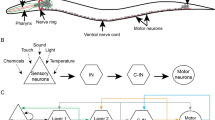Summary
Using a technique of recording the behavior of individual nematodes during exposure to various solutions, it was demonstrated thatC. elegans made more reversal behaviors after transfer to solutions of lower oxygen tension than higher. The response was stronger after the first hour in the apparatus than initially. This change was not dependent on reduced oxygen availability during the initial period. Starvation is the most likely cause of this change. A variety of mutant strains ofC. elegans that are defective in response to most known chemotactic stimuli, including two strains that have been shown to be severely abnormal in the ciliated endings of all sensory neurons of the worm's snout, all responded to changes in oxygen tension. This observation suggests that oxygen is sensed internally rather than by specialized peripheral receptor cells.
Similar content being viewed by others
References
Anderson, G.L.: Responses of dauerlarvae ofCaenorhabditis elegans (Nematoda: Rhabditidae) to thermal stress and oxygen deprivation. Can. J. Zool.56, 1786–1791 (1978)
Bird, A.F.: The attractiveness of roots to the plant parasitic nematodesMeloidogyne javanica andM. hapla. Nematologica4, 322–335 (1959)
Brenner, S.: The genetics ofCaenorhabditis elegans. Genetics77, 71–94 (1974)
Cassada, R.C., Russell, R.L.: The dauerlarvae, a post-embryonic developmental variant of the nematodeCaenorhabditis elegans. Dev. Biol.46, 326–342 (1975)
Culotti, J.G., Russell, R.L.: Osmotic avoidance defective mutants of the nematodeCaenorhabditis elegans. Genetics90, 243–256 (1978)
Dusenbery, D.B.: Chemotactic behavior of mutants of the nematodeCaenorhabditis elegans that are defective in their attraction to sodium chloride. J. Exp. Zool.198, 342–351 (1976)
Dusenbery, D.B.: Chemotactic behavior of mutants of the nematodeCaenorhabditis elegans that are defective in osmotic avoidance. J. Comp. Physiol. (in press) (1980a)
Dusenbery, D.B.: Responses of the nematodeCaenorhabditis elegans to controlled chemical stimulation. J. Comp. Physiol.136, 327–331 (1980b)
Dusenbery, D.B., Sheridan, R.E., Russell, R.L.: Chemotaxis-defective mutants of the nematodeCaenorhabditis elegans. Genetics80, 297–309 (1975)
Edgar, R.S., Wood, W.B.: The nematodeCaenorhabditis elegans, a new organism for intensive biological study. Science198, 1285–1286 (1977)
Johnson, R.N., Viglierchio, D.R.: The accumulation of plant parasitic nematodes around carbon dioxide and oxygen. Proc. Helminthol. Soc. Wash.28, 171–174 (1961)
Lewis, J.A., Hodgkin, J.A.: Specific neuro-anatomical changes in chemo sensory mutants of the nematodeCaenorhabditis elegans. J. Comp. Neurol.172, 489–510 (1977)
MacArthur, R.H., Wilson, E.O.: The theory of island biogeography. Princeton: Princeton Univ. Press 1967
Ward, S.: Nematode chemotaxis and chemoreceptors. In: Taxis and behavior (Receptors and recognition, Series B, Vol. 5). Hazelbauer, G.L. (ed.). London: Chapman and Hall 1978
Ward, S., Thomson, N., White, J.G., Brenner, S.: Electron microscopical reconstruction of the anterior sensory anatomy of the nematodeCaenorhabditis elegans. J. Comp. Neurol.160, 313–338 (1975)
Ware, R.W., Clark, D., CrOssland, K., Russell, R.L.: The nerve ring of the nematodeCaenorhabditis elegans: sensory input and motor output. J. Comp. Neurol.162, 71–110 (1975)
Author information
Authors and Affiliations
Additional information
I thank Deborah Higgins for technical assistance. This work was supported by a grant awarded by the Biomedical Research Support Grant Program of the National Institutes of Health.
Rights and permissions
About this article
Cite this article
Dusenbery, D.B. Appetitive response of the nematodeCaenorhabditis elegans to oxygen. J. Comp. Physiol. 136, 333–336 (1980). https://doi.org/10.1007/BF00657353
Accepted:
Issue Date:
DOI: https://doi.org/10.1007/BF00657353




